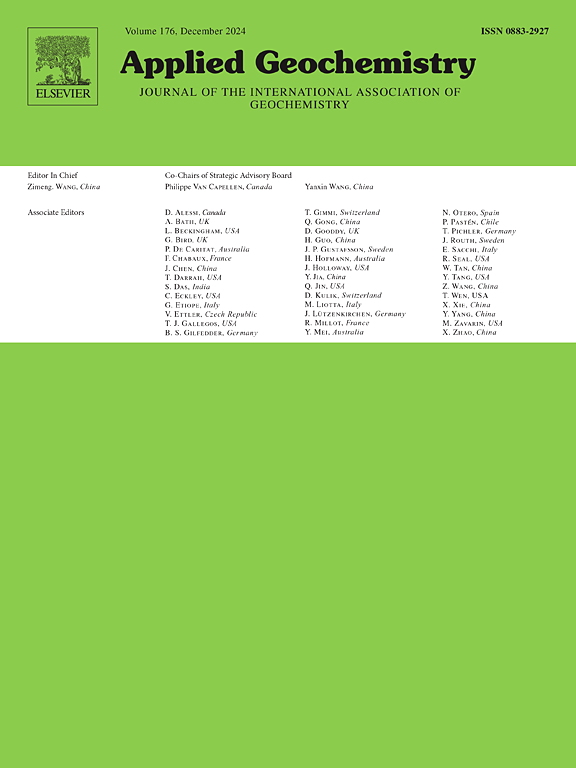Combining sequential Gaussian co-simulation and Monte Carlo dropout-based deep learning models for geochemical anomaly detection and uncertainty assessment
IF 3.4
3区 地球科学
Q1 GEOCHEMISTRY & GEOPHYSICS
引用次数: 0
Abstract
Geochemical anomaly detection is crucial for guiding mineral exploration toward prospective mineral deposits. However, this task is inherently challenging due to uncertainties arising from sparse sampling, spatial variability of geochemical patterns, model limitations. To evaluate the uncertainties associated with spatial variability and model limitations, this study proposes an innovative approach that combines sequential Gaussian co-simulation (SGCS) with Monte Carlo (MC) Dropout-based Convolutional Neural Networks (CNNs) for geochemical anomaly detection and uncertainty quantification. The SGCS method generates multiple realizations of geochemical data, facilitating the quantification of uncertainty in geochemical patterns by considering potential distributions at unsampled locations. These realizations are utilized to augment the training dataset for CNNs, thereby enhancing the model's robustness in anomaly detection. The MC Dropout technique is integrated into the CNN model to evaluate prediction uncertainties, providing critical insights for decision-making under uncertainty. The proposed methodology was applied to the northwestern part of Sichuan Province, China, a region known for gold mineralization. Results indicate that all known gold deposits fall within areas where the anomaly probability exceeds 0.843. By integrating predicted probabilities with associated uncertainties, the spatial distribution of a confidence index is derived, offering a structured guide for subsequent exploration. This integrated framework enhances anomaly detection accuracy and provides robust uncertainty estimates, ultimately enabling more efficient and informed exploration strategies in high-uncertainty environments.
结合顺序高斯联合模拟和蒙特卡罗dropout深度学习模型的地球化学异常检测与不确定性评估
地球化学异常探测是指导找矿找矿的重要手段。然而,由于采样稀疏、地球化学模式的空间变异性、模型局限性等因素的不确定性,这项任务本身就具有挑战性。为了评估与空间变异性和模型局限性相关的不确定性,本研究提出了一种将顺序高斯联合模拟(SGCS)与基于蒙特卡罗(MC) dropout的卷积神经网络(cnn)相结合的创新方法,用于地球化学异常检测和不确定性量化。SGCS方法生成了地球化学数据的多种实现,通过考虑未采样位置的潜在分布,促进了地球化学模式不确定性的量化。这些实现被用于增强cnn的训练数据集,从而增强模型在异常检测中的鲁棒性。将MC Dropout技术集成到CNN模型中以评估预测不确定性,为不确定性下的决策提供关键见解。将该方法应用于中国四川西北部金矿化地区。结果表明,所有已知金矿均位于异常概率超过0.843的区域内。通过将预测概率与相关不确定性相结合,推导出置信指数的空间分布,为后续勘探提供结构化指导。该集成框架提高了异常检测的准确性,并提供了强大的不确定性估计,最终在高不确定性环境中实现更高效、更明智的勘探策略。
本文章由计算机程序翻译,如有差异,请以英文原文为准。
求助全文
约1分钟内获得全文
求助全文
来源期刊

Applied Geochemistry
地学-地球化学与地球物理
CiteScore
6.10
自引率
8.80%
发文量
272
审稿时长
65 days
期刊介绍:
Applied Geochemistry is an international journal devoted to publication of original research papers, rapid research communications and selected review papers in geochemistry and urban geochemistry which have some practical application to an aspect of human endeavour, such as the preservation of the environment, health, waste disposal and the search for resources. Papers on applications of inorganic, organic and isotope geochemistry and geochemical processes are therefore welcome provided they meet the main criterion. Spatial and temporal monitoring case studies are only of interest to our international readership if they present new ideas of broad application.
Topics covered include: (1) Environmental geochemistry (including natural and anthropogenic aspects, and protection and remediation strategies); (2) Hydrogeochemistry (surface and groundwater); (3) Medical (urban) geochemistry; (4) The search for energy resources (in particular unconventional oil and gas or emerging metal resources); (5) Energy exploitation (in particular geothermal energy and CCS); (6) Upgrading of energy and mineral resources where there is a direct geochemical application; and (7) Waste disposal, including nuclear waste disposal.
 求助内容:
求助内容: 应助结果提醒方式:
应助结果提醒方式:


